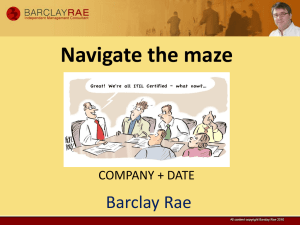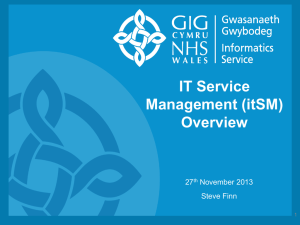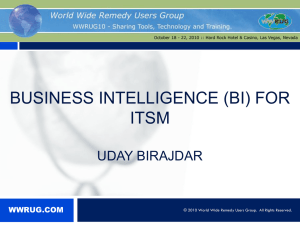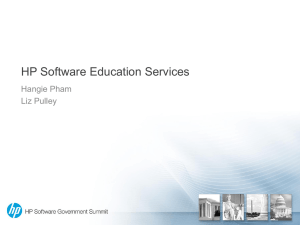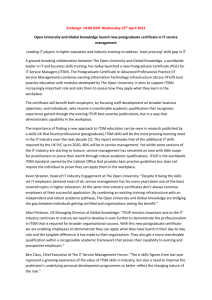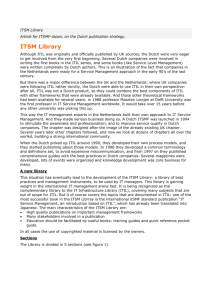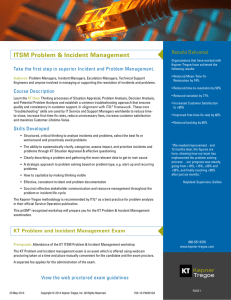NCR IT Service Management Policy
advertisement
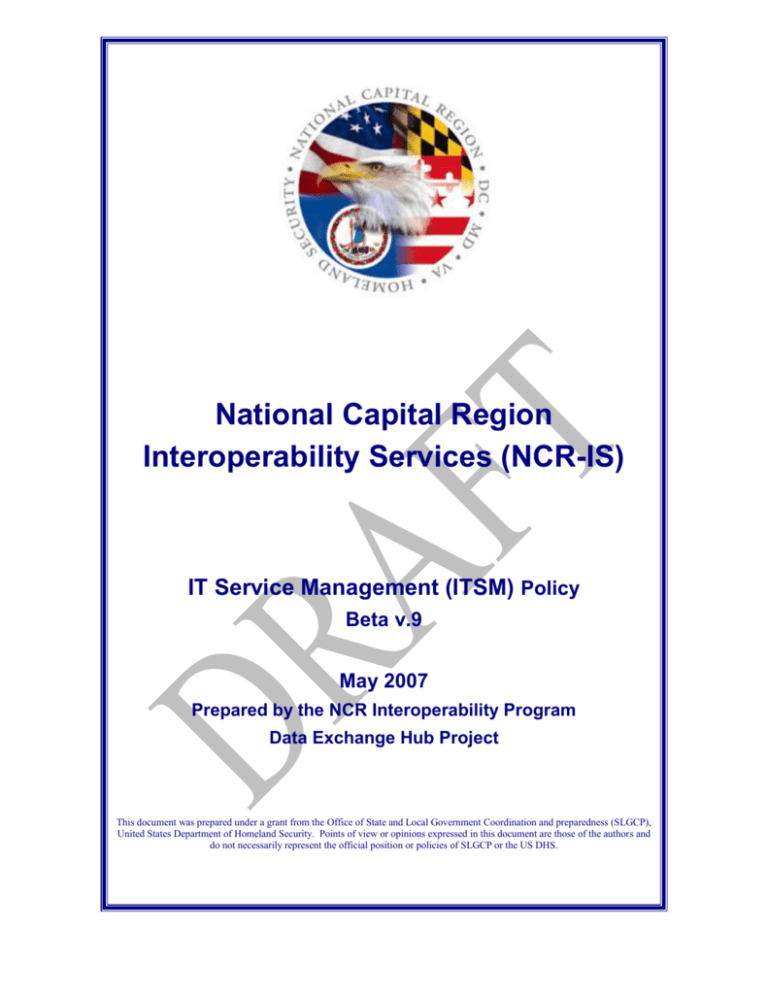
National Capital Region Interoperability Services (NCR-IS) IT Service Management (ITSM) Policy Beta v.9 May 2007 Prepared by the NCR Interoperability Program Data Exchange Hub Project This document was prepared under a grant from the Office of State and Local Government Coordination and preparedness (SLGCP), United States Department of Homeland Security. Points of view or opinions expressed in this document are those of the authors and do not necessarily represent the official position or policies of SLGCP or the US DHS. NCR Interoperability Services (NCR-IS) IT Service Management (ITSM) Policy Revision History Date Description Authorized by 4/25/2007 First draft of converted Service Catalog into ITSM Policy document Stephan Papadopulos 4/30/2007 Updated revised draft Stephan Papadopulos 5/2/2007 Updated to replace detailed Service Catalog with reference to actual catalog Stephan Papadopulos 6/5/2007 Reviewed & approved by ARC for submission to the Metro CIO Committee Lynn Hadden May 2007 i NCR Interoperability Services (NCR-IS) IT Service Management (ITSM) Policy Forward The information provided in this section is intended to provide context for the draft policy document contained herein. In early October 2006, the Metropolitan Washington Council of Governments (MWCOG) Chief Information Officer (CIO) Committee approved the establishment of the MWCOG Governance Sub-Committee to make recommendations on the short and long-term governance of the National Capital Region Interoperability Services (NCR-IS) infrastructure, a region-wide entity that would provide service and support to the applications, data exchanges and infrastructure created by the National Capital Region Interoperability Program (NCRIP) projects (Data Exchange Hub [DEH]; NCRnet; Regional Wireless Broadband Network [RWBN]) as the interoperability part of the NCR's Homeland Security Plan. The NCR-IS would provide a single point of contact that all NCR jurisdictions participating with the NCRIP projects would be able to use to report problems, request service or seek support for the operation of NCRIP applications, data exchanges and infrastructure. Based upon the work of the NOFWG, the CIO Governance Subcommittee drafted for consideration / approval by the Metro CIO Committee, a MWCOG resolution to create a governing body – the Interoperability Council (IC) of the Metropolitan Washington Council of Governments – to guide and help support the NCR-IS function. The resolution was approved and submitted to the MWCOG Chief Administrative Officers (CAO) Committee, who approved creation of the IC at their March 2007 meeting. The IC Charter was subsequently approved by the MWCOG Board of Directors. Key responsibilities of the Interoperability Council include: establish regional policies regarding security and privacy of data; evaluate the cost effectiveness and total cost of ownership for the proposed program identify and recommend methods of funding the project recommend or authorize contracts in support of the on-going delivery of interoperability services. The purpose of this document is to define the policy that will govern the on-going service support for regional interoperability assets. May 2007 ii NCR Interoperability Services (NCR-IS) IT Service Management (ITSM) Policy Executive Summary NCR-IS Partners require that the NCR-IS IT Infrastructure reliably deliver the appropriate IT services when they are needed. The NCR-IS is currently designing an Information Technology Infrastructure Library (ITIL) compliant IT Service Management (ITSM) capability to support NCR-IS Partners. The ITSM function will manage the comprehensive IT services required by the NCR-IS business partners. The ultimate goal is to provide a single IT Service Desk (i.e. single number to call) for all issues related to maintaining and supporting regional interoperable communications. ITIL-Based IT Service Management ITIL provides a consistent and coherent set of best practices for IT Service Management processes. These ITSM processes are intended to be implemented to support, not dictate, the business processes of an organization. ITIL is based on the collective experience of commercial and governmental agencies worldwide and is fast becoming the de facto standard for ITSM, ITIL is the most widely accepted approach to ITSM in the world and it will provide a sound foundation for designing and building ITSM capabilities for the NCR-IS IT Infrastructure. ITIL contains an integrated set of well-documented processes including: Service Desk, Incident Management, Problem Management, Change Management, Release Management, Configuration Management, Service Level Management, Availability Management, Capacity Management, Financial Management for IT services and IT Service Continuity Management. These processes are used to manage, deliver, and measure the provisioning of services. Figure 1 below depicts the overall ITIL framework and the relationship between ITSM processes and services. Figure 1. ITIL Framework May 2007 iii NCR Interoperability Services (NCR-IS) IT Service Management (ITSM) Policy The policy for the NCR-IS IT Infrastructure is to use this framework as a guideline for formulating our ITSM strategy for the region and for supporting the IT Services Catalog to be available to NCR-IS Partners using the NCR-IS IT Infrastructure for secure wired or wireless networking and for facilitating applications and exchanges. ITSM Planning Approach Implementing ITSM processes and capabilities takes careful planning and a recognition that comprehensive ITSM cannot be built at once. The NCR-IS is identifying the short-term and long-term ITSM processes and services. Much of the effort is currently focused on developing an NCR-IS IT Customer Oriented Service Catalog which describes the professional and IT services that will be offered. Initially the scope of the NCR-IS Service catalog will pertain to providing support for the initial Exchanges and related NCR-IS initiated networking infrastructures which include: NCR-IS Data Exchange Hub NCRnet RWBN (Regional Wireless Broadband Network) The following IT support process and service domains and their relationships form the foundation of the NCR-IS ITIL-based ITSM framework: IT Service Support Processes including: Incident Management Problem Management Configuration Management Change Management Release Management IT Service Delivery Processes Service Level Management Capacity Management Availability Management Continuity Management Financial Management IT Customer-Oriented Service Catalog May 2007 ICT Infrastructure Management Services Application Management Services Security Management Services Business Services iv NCR Interoperability Services (NCR-IS) IT Service Management (ITSM) Policy Each of the domains above and their interrelationships are described in the ITSM Policy. While definition of the NCR-IS ITSM Policy and the NCR-IS Operational Plan will be an iterative and on-going process as the enterprise matures, it is the purpose of this document to provide the foundation for that dialog in order to provide guidance on the processes and services necessary to provide interim maintenance and support for the NCR-IS DEH, NCRnet and RWBN beginning September 2007. May 2007 v NCR Interoperability Services (NCR-IS) IT Service Management (ITSM) Policy Table of Contents 1 OVERVIEW ......................................................................................................................................... 1 2 PURPOSE............................................................................................................................................. 1 3 OBJECTIVES ...................................................................................................................................... 2 4 SCOPE .................................................................................................................................................. 3 5 THE NCR-IS ITSM POLICY ............................................................................................................ 4 5.1 IT SERVICE MANAGEMENT (ITSM) PROCESSES ............................................................................ 6 5.1.1 IT Service Support Processes ................................................................................................... 6 5.1.1.1 5.1.1.2 5.1.1.3 5.1.1.4 5.1.1.5 5.1.2 Incident Management ...................................................................................................................... 6 Problem Management ..................................................................................................................... 6 Configuration Management............................................................................................................. 6 Change Management ....................................................................................................................... 6 Release Management ...................................................................................................................... 7 IT Service Delivery Processes .................................................................................................. 7 5.1.2.1 5.1.2.2 5.1.2.3 5.1.2.4 5.1.2.5 Service Level Management ............................................................................................................. 7 Capacity Management ..................................................................................................................... 7 Availability Management ................................................................................................................ 7 Continuity Management .................................................................................................................. 8 Financial Management .................................................................................................................... 8 5.2 IT CUSTOMER-ORIENTED SERVICE CATALOG ............................................................................... 8 5.2.1 ICT Infrastructure Management Services ................................................................................. 9 5.2.2 Application / Exchange Management Services ......................................................................... 9 5.2.3 Security Management Services ................................................................................................. 9 5.2.4 Business Services .....................................................................................................................10 List of Figures Figure 1. Figure 2. Figure 3. Figure 4. ITIL Framework ____________________________________________________________ iii NCR-IS SOA Governance Structure ______________________________________________ 1 NCR-IS Service Desk Process ____________________________________________________ 3 The ITIL Service Management Framework Relationships ______________________________ 5 May 2007 vi NCR Interoperability Services (NCR-IS) IT Service Management (ITSM) Policy 1 Overview The NCR-IS Architecture is designed using a Services Oriented Architecture, that is currently comprised of three major components, the Data Exchange Hub (DEH), NCRnet and Regional Wireless Broadband Network (RWBN). This architecture will utilize the IT Infrastructure Library framework as a basis for defining and implementing its Service Management Strategy for the NCR–IS. Maintenance and operational governance will control the production of artifacts and monitor compliance with standards. This will help stakeholders measure whether projects requesting support from the NCR-IS infrastructure are aligned with regional standards and meet the needs of the business users. For more information, see the figure below. Figure 2. NCR-IS SOA Governance Structure 2 Purpose The purpose of this document is to set forth the policy for establishing the NCR-IS IT Service Management (ITSM) function. This document is intended to provide policies for the processes and services that will provided by the NCR-IS ITSM organization. May 2007 1 NCR Interoperability Services (NCR-IS) IT Service Management (ITSM) Policy 3 Objectives The main objective of the NCR-IS ITSM Policy is to document policies governing the establishment of the NCR-IS IT support processes and services. The policy will reference the initial services are processes that will be delivered and supported by the NCR-IS ITSM organization. The policy can also provide a baseline for a Service Level Agreements (SLA), or even potentially replace SLAs in some cases. It will provide a basis from which to document procedures and processes in the NCR-IS. In order to be effective the ITSM Policy must be understood and embraced by the customers and jurisdictions wishing to use the NCR-IS. The NCR-IS will provide leading, best practices IT service support by building upon the industry standard Information Technology Infrastructure Library (ITIL). Being a framework, ITIL describes the contours of organizing Service Management. The models show the goals, general activities, inputs and outputs of the various processes, which can be incorporated within organizations. ITIL does not cast in stone every action required on a day-to-day basis because that is something which differs from organization to organization. Instead it focuses on best practice that can be utilized in different ways according to need. The scope of ITIL and its individual elements is shown in Figure 1 in the Executive Summary. By emphasizing the relationships between the processes, any lack of communication and co-operation between various IS functions can be minimized or eliminated. ITIL provides a proven method for planning common processes, roles and activities with appropriate reference to each other and how the communication lines should function between them. Support for regional IT solutions will require a coordinated effort between existing Service Desks of the NCR-IS Partners within the region and the NCR-IS. Considerable planning and coordination will need to occur. IT and ESF Staff from NCR-IS Partners will be the primary users of the NCR-IS. At a conceptual level, it is envisioned that support will be a multi-tiered process. Most calls will originate within the Service Desks of the NCR-IS Partners and then be escalated as needed to the NCR-IS Service Desk. This document is an attempt to define the processes and services that would be provided by the NCR-IS at the Tier 2 and Tier 3 levels highlighted in the NCR-IS IT Service Management Process diagram below. The ultimate goal of the NCR-IS is to provide a single IT Service Desk (i.e. single number to call) for all issues related to maintaining and supporting regional Interoperable Communications. May 2007 2 NCR Interoperability Services (NCR-IS) IT Service Management (ITSM) Policy Addressed by NCR-IS Directly No Resolved A End Yes No Tier 1 Support: Isolate Responsibility to User, Application / DEH, or Network Tier 1 Support: Diagnose, Evaluate, and Attempt Service / Problem Repair Yes Resolved Tier 1 Support: Feedback to End User End No NCR-IS IT Service Management (Tier 2 and 3) Network / Server Monitors DRAFT Yes End User Service Request / Incident – Self-Service Support (Tier 0) NCR Partner IT Support (Tier 1) NCR Partner End User (Tier 0) NCR-IS Integrated IT Service Management Process Network / Fiber A Tier 2 Svc Desk: Evaluate Request / Incident and Confirm Responsibility Wireless Network Tier 3 Support: Engineer Assigned to Resolve Network / Fiber Request / Incident RWBN: Monitoring System Identifies MO Issue Yes Tier 2 Svc Desk: Feedback to Tier 1 Support Team Yes Tier 4 Support: Initiate Third-Party to Resolve Requests / Incidents Resolved Tier 3 Support: Engineer Assigned to Resolve Hardware Request / Incident Application / Tier 3 Support: DEH Engineer Assigned to Resolve Application Request / Incident DEH: Monitoring System Identifies MO Issue Request Initiator Tier 3 Support: Engineer Assigned to Resolve Wireless Request / Incident Responsibility HW Jurisdiction: Monitoring System identifies MO Issue Tier 1 Support End User No Third Party Required Yes Resolved No No NCRnet: Monitoring System Identifies MO Issue Figure 3. NCR-IS Service Desk Process 4 Scope Initially the scope of the NCR-IS ITSM Policy will be to provide support for the initial Exchanges and related NCR-IS initiated networking infrastructures which include: NCR-IS Data Exchange Hub - The purpose of the DEH is to enable the secure, efficient exchange of information (text, voice, video and multimedia) between Emergency Support Functions (ESFs) in region. NCRnet - The primary purpose of the NCRnet is to provide a reliable and available, high speed, fiber optic network to allow emergency responders, police, fire, and other supporting personnel to communicate in the event of natural or man-made emergencies or disasters. It is independently operated and maintained by the NCR jurisdictions and its designees. RWBN - The primary purpose of the RWBN is to provide a mobile, high speed, and available wireless voice and data infrastructure to allow emergency personnel to communicate in the event of natural or man-made emergencies or disasters. It is independently operated and maintained by the NCR jurisdictions and its designees. May 2007 3 NCR Interoperability Services (NCR-IS) IT Service Management (ITSM) Policy The following IT Service Management domains and the relationships between them are discussed in this policy: IT Service Support Processes including: Incident Management Problem Management Configuration Management Change Management Release Management IT Service Delivery Processes Service Level Management Capacity Management Availability Management Continuity Management Financial Management IT Customer-Oriented Service Catalog 5 ICT Infrastructure Management Services Application Management Services Security Management Services Business Services The NCR-IS ITSM Policy This NCR-IS ITSM Policy will describe in detail the ITSM processes (including Service Support and Service Delivery); and ICT Infrastructure Management, Application Management, Security Management, and Business services envisioned for the NCR-IS. The diagram shown below identifies the relationship between the ITSM processes and services. May 2007 4 NCR Interoperability Services (NCR-IS) IT Service Management (ITSM) Policy Figure 4. The ITIL Service Management Framework Relationships May 2007 5 NCR Interoperability Services (NCR-IS) IT Service Management (ITSM) Policy 5.1 IT Service Management (ITSM) Processes Processes associated with IT Service Management specifically IT Service Support and IT Service Delivery processes are defined in the table below. Initially NCR-IS IT Service Management (ITSM) will focus on Incident Management, Configuration Management, Change Management, Service Level Management and Release Management. Future phases will incorporate the remaining IT Service Support and Delivery Processes. 5.1.1 IT Service Support Processes 5.1.1.1 Description: 5.1.1.2 Description: Incident Management The primary goal of the Incident Management process is to restore normal service operation as quickly as possible and minimize the adverse impact on business operations, thus ensuring that the best possible levels of service quality and availability are maintained. ‘Normal service operation’ is defined here as service operation within Service Level Agreement (SLA) limits. Problem Management Problem Management minimizes the adverse impact of Incidents and Problems on the business that are caused by errors within the IT Infrastructure, and prevents recurrence of Incidents related to these errors. In order to achieve this goal, Problem Management seeks to get to the root cause of Incidents and then initiate actions to improve or correct the situation.Problem Management also needs to liaise closely with the availability management process to identify these trends and instigate remedial action. 5.1.1.3 Description: 5.1.1.4 Description: Configuration Management Configuration Management identifies relationships between an item that is to be changed and any other components of the infrastructure, thus allowing the owners of these components to be involved in the impact assessment process. Change Management Change Management process ensures that standardized methods and procedures are used for efficient and prompt handling of all changes, in order to minimize the impact of Change-related Incidents upon service quality, and consequently to improve the day-to-day operations of the organization.The Change Management process depends on the accuracy of the configuration data to ensure the full impact of making changes is known. There is therefore a very close relationship between Configuration Management, May 2007 Page 6 NCR Interoperability Services (NCR-IS) IT Service Management (ITSM) Policy Release Management and Change Management. 5.1.1.5 Description: Release Management Changes may often result in the need for new hardware, new versions of software, and/or new documentation, created inhouse or bought in, to be controlled and distributed, as part of a new ‘packaged Release’. Release Management if for ensuring secure, managed rollout should be closely integrated with those for Change Management and Configuration Management. Release procedures may also be an integral part of Incident Management and Problem Management, as well as being closely linked to the CMDB in order to maintain up-todate records. 5.1.2 IT Service Delivery Processes 5.1.2.1 Description: 5.1.2.2 Description: 5.1.2.3 May 2007 Service Level Management The Service Level Management (SLM) process is responsible for ensuring Service Level Agreements (SLAs) and other contracts are met, and for ensuring that any adverse impact on service quality is kept to a minimum. The process involves assessing the impact of Changes upon service quality and SLAs, both when Changes are proposed and after they have been implemented. Some of the most important targets set in the SLAs will relate to service availability and thus require Incident resolution within agreed periods. SLM is the hinge for Service Support and Service Delivery. It cannot function in isolation as it relies on the existence and effective and efficient working of other processes. An SLA without underpinning support processes is useless, as there is no basis for agreeing to its content. Capacity Management Capacity Management is responsible for ensuring adequate capacity is available at all times to meet the requirements of the business. It is directly related to the business requirements and is not simply about the performance of the system’s components, individually or collectively. Capacity Management is involved in Incident resolution and Problem identification for those difficulties relating to capacity issues. Availability Management Page 7 NCR Interoperability Services (NCR-IS) IT Service Management (ITSM) Policy Description: 5.1.2.4 Description: 5.1.2.5 Description: 5.2 Availability Management is concerned with the design, implementation, measurement and management of IT services to ensure the stated business requirements for availability are consistently met. Availability Management requires an understanding of the reasons why IT service failures occur and the time taken to resume service. Incident Management and Problem Management provide a key input to ensure the appropriate corrective actions. Continuity Management IT Service Continuity must be derived so as to be flexible enough to support all the contingency options anticipated by the business in their Business Continuity Plans. And where IT is not the only service provider affected, it is necessary to consider how IS support for the other internal service providers may, in turn, be affected. When it comes to deciding on continuity strategies, the business may well take a different risk-based perspective than that adopted or anticipated by IT. Financial Management Financial Management is responsible for accounting for the costs (costing) and return on IT service investments (IT portfolio management), and for any aspects of recovering costs from the Customers (charging). It requires good interfaces with Capacity Management, Configuration Management (asset data) and Service Level Management to identify the true costs of service. Financial Management is likely to work closely with Business Relationship Management and the IT organization during the negotiations of the IT organization’s budgets and individual Customer’s IT spending. IT Customer-Oriented Service Catalog The IT Customer-Oriented Service Catalog describes the IT services that will be provided by the NCR-IS to NCR-IS Partner jurisdiction / agency users. Initially, the NCR-IS will be focused on providing the core, necessary services to operate the NCR-IS infrastructure. As the NCR-IS matures, it will offer additional performance and professional services as required by its customers. IT services can be categorized in the following areas: ICT Infrastructure Management Services Application / Exchange Management Services Security Management Services May 2007 Page 8 NCR Interoperability Services (NCR-IS) IT Service Management (ITSM) Policy Business Services The following descriptions offer an overview of the different IT service types. The NCR-IS Customer-Oriented Service Catalog will contain additional details for each IT service provided by the NCR-IS. 5.2.1 ICT Infrastructure Management Services Information and Communications Technology (ICT) services will support the design / planning, deployment, operations, and technical support of the entire NCR-IS infrastructure. The NCR-IS infrastructure may include application and database servers, distributed systems, networks and network components, desktop workstations, and mobile devices. The infrastructure will evolve as the NCR-IS matures and changes to meet increasing operational needs. Initially, NCRIP project teams will support and deliver the design / planning and deployment services related to any ICT infrastructure component. The NCR-IS will support deployment into the NCR-IS environment and will primarily provide operations and technical support services once the infrastructure is deployed. Examples of ICT Infrastructure Management Services include: Account Management Services Connectivity Services Data Center Services Network Services. The NCR-IS Customer-Oriented Service Catalog will maintain an on-going record of the specific IT infrastructure management services to be provided by the NCR-IS. 5.2.2 Application / Exchange Management Services Application / Exchange Management services address the complex subject of managing applications and exchanges throughout their lifecycle. Application / Exchange services include business requirements, design, build, deployment, operations, optimization, and data management services. Initially, NCRIP project teams will be responsible for requirements, design, build, and deployment services related to applications and exchanges. The NCR-IS will work in conjunction with the NCRIP teams during deployment and will then offer ongoing operational services. The NCR-IS Service Catalog will maintain a record of the specific application / exchange services to be provided by the NCR-IS over time. 5.2.3 Security Management Services The goal of NCR-IS a Security Management service is two-fold: Provide services to meet the external security requirements. These result from the security requirements in the various SLAs. These external requirements for security May 2007 Page 9 NCR Interoperability Services (NCR-IS) IT Service Management (ITSM) Policy also stem from contracts, legislation and any imposed security policies of NCR-IS Partners. Provide services to meet the internal security requirements. This is required to assure the IT service provider’s own continuity. It is also necessary to simplify the Service Level Management for information security. After all, managing a large number of different SLAs is much more complex than managing a small number. Therefore, for instance, a certain basic level of security (the so-called standard security baseline) needs to be established. The NCR-IS Security Management services are governed by the NCR-IS Security Policy. That policy sets forth the approved and disapproved uses of NCR Interoperability Services. Within the ITIL framework, security information is contained in the Service Level Agreements established for each service offered by the NCR-IS. The NCR-IS acknowledges that security processes must support the business needs. Furthermore, to use what is already available, standard ITIL processes have integrated Security Management principles wherever possible. The integrated security tasks within each ITIL process should take care of the security aspects in their specific area, but the point of control of these tasks is centralized by the security management process. Security management services ensure the confidentiality, integrity, and availability of information and information systems. Privacy, anonymity, and verifiability can be extrapolated from these information security pillars. Security management seeks to apply measures, or security controls, that are preventive, reductive, detective, repressive, and corrective in nature. Evaluation processes are also employed to examine and report on security incidents which may or may not have impacted business services and compliance with the corresponding SLAs. Because ITIL contains management processes for information technology, the management of personnel and physical entities are not specifically addressed. Measures and operations related to the management of people and facilities can be different from those which manage information technology. ITIL is a framework for managing information technology, not facilities or people. Measures and operations for personnel and facilities can be defined during the evolution of the NCR-IS. 5.2.4 Business Services The NCR-IS will need to interact with NCR-IS Partners on a regular basis to identify business needs and opportunities and undertake appropriate capacity planning in anticipation of future applications and exchanges. Once a specific business need is identified, the NCR-IS will need to assist business users in planning and preparing documentation for review and consideration by the MWCOG ARC and CIOs who will assess conformance of the proposed solution with the NCR-IS architecture Additionally, NCR-IS, following in the footsteps of the NCRIP DEH Project, will need to provide assistance in educating and training NCR-IS Partner staff on emerging technologies and solutions that will be deployed within the NCR-IS Infrastructure. Initially, the NCR-IS will provide the following types of business services: Knowledge Management Services Project Management Services May 2007 Page 10 NCR Interoperability Services (NCR-IS) IT Service Management (ITSM) Policy The NCR-IS Service Catalog will maintain a record of the specific business services to be provided by the NCR-IS and it will be updated over time as services evolve keep up with customer needs. May 2007 Page 11
